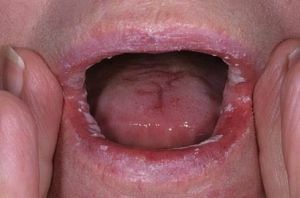 Thrush on the lips( candidiasis) - fungal infection of the oral cavity, the main cause of which is infection with opportunistic microorganisms of the genus Candida. Also, a painful microflora can spread to internal organs, skin and mucous membranes.
Thrush on the lips( candidiasis) - fungal infection of the oral cavity, the main cause of which is infection with opportunistic microorganisms of the genus Candida. Also, a painful microflora can spread to internal organs, skin and mucous membranes.
The main causative agent of thrush is Candida fungi, present in the body of each person in small quantities. Negative action of the pathogen is neutralized by other bacteria. Under favorable conditions, their active reproduction begins, accompanied by toxic secretions and suppression of the patient's immunity. The resulting imbalance ends with the appearance of candidiasis.

At the moment, science knows about 170 species of Candida fungi. They are found not only on skin integuments or internal organs of a person, but also in soil, on food products. In general, they may well live on any surfaces where there is an environment favorable for them. The development of candidiasis provokes only 20 varieties, but most often doctors identify only 4:
- C.parapsilosis;
- C.tropicalis;
- C.glabrata;
- C.albicans.
Contents of
- Reasons - to know to avoid!
- Way infection
- Types of fungal infections
- clinical picture
- general nature of symptoms
- Psevodmembranoznaya form
- erythematosus form
- Hypertrophic view
- Erosive-ulcerative form
- Candida cheilitis
- The diagnosis
- Medical assistance
- Local therapy
- Systemic exposure
- Preventive measures
reasons -know to avoid!
The following factors lead to the development of candidiasis on the lips and in various areas of the skin:
- a decrease in the protective function of immunity, frequent illnesses;
- the use in a plenty of medicines, especially antibiotics, contraceptive tablets;
- cold, hypothermia;
- sudden change of climate or weather conditions;
- change in hormone levels;
- of the endocrine system;
- ignoring personal hygiene rules;
- diabetes mellitus;
- AIDS.
In addition to these factors, there is a certain group of people who fall into the risk zone and can become a "victim" of candidiasis with fungus development in the lip area with a higher probability. Among them are:
- of pregnant women( especially in the first trimester);
- of newborn babies with diagnosed gastrointestinal diseases;
- children aged 1 to 3 years;
- persons with diseases of the stomach and intestines;
- preterm infants;
- patients with oncological diseases undergoing chemotherapy;
- of the elderly, who, due to age, are difficult to regenerate the tissues of the mucous membranes.
Pathways of infection
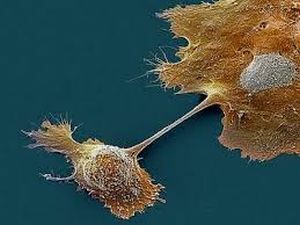
Fungus under the microscope
In most cases, the cause of the disease is a change in its own flora and a sharp increase in the number of Candida fungi, although it is sometimes possible to infect from the outside.
Immunosuppression is the best period for increasing the Candida population. Microorganisms begin to affect the cells of the epithelium, spreading on the surface, and after penetrating inside. But even with the restoration of the protective function, it is not possible to achieve the proper balance, so the fungus continues its destructive effect.
After the treatment, relapse of the disease is likely. This is due to the fact that once the immunity is again inhibited, the Candida fungus immediately begins its multiplication, manifesting itself on the lips and other mucous membranes, which requires repeated treatment.
Varieties of fungal lesions
By the nature of the flow thrush is divided into:
- sharp;
- chronic;
- recurrent - with periods of exacerbation and remission;
- persistent is a persistent process that is difficult to treat.
Depending on the location of the lesion fungi Candida, thrush in the mouth is divided into:
- candidal cheilitis( hailosis) - fungal infection of the red border of the lips;
- candidiasis glossitis - infection of the tongue;
- stomatitis - inflammation of the oral mucosa;
- pharyngitis - damage to the mucous membrane and lymphoid tissue of the pharynx;
- gingivitis is a gum disease;
- tonsillitis - pathology of palatine tonsils.
Forms of candidiasis of the lips, depending on the modification of the disease over time:
- is pseudomembranous;
- is atrophic;
- Candida leukoplakia;
- erosive and ulcerative.
Clinical picture
At the first stage of the disease, changes in the state of the mucous membrane of the mouth are noticeable. When examined, there is hyperemia( overflow of blood vessels), puffiness of the tongue, cheeks, sometimes swelling also passes to the palate and tonsils. Later inflammation intensifies and affects a large part of the tissues. Next appear patches of white, reminiscent of plaque or cottage cheese. Because of this specific symptom, the disease was called thrush. 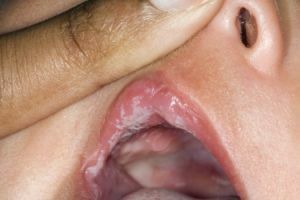
White coating on the oral mucosa and lips is a family of Candida fungi, capable of rapid reproduction. Later, the infection seizes untouched foci, starting with the lips and gradually covering the entire oral cavity. The plaque can have a white, yellowish or even grayish tinge. In the first stage, such films are removed mechanically without damaging the integrity of the tissue.
If the patient has not been treated, the fungus passes to the vocal cords, the inner side of the sinuses of the nose, pharynx, esophagus, stomach. One of the signs of the spread of thrush to the ligaments is the hoarseness of the voice, its gradual abating.
In chronic candidiasis, white coating thickens, causing with it swelling of the skin and an increase in blood vessels. Films are removed poorly, leaving wounds in the place where they were located. On the tongue there are visible grooves, which are also filled with bloom.
The patient indicates a subjective sensation: a feeling of an increase in the tongue, dry mouth, burning sensation of the mucous membranes. The picture is aggravated by the use of hot food or drinks.
General symptomatology
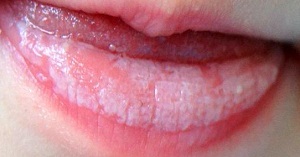
White scurf on the lips - the first alarm bell
There are no clearly expressed symptoms in candidiasis, but a person thinks about treatment only after noticing a white coating on the lips that points to the fungus;parallel to children, and more often than adults, there are small cracks in the corners of the mouth.
White plaque can also spread on the inner surface of the cheeks, tongue. If the film is damaged, bleeding appears, erosion. It is visible puffiness, mainly near wounds.
In addition to the local reaction to the propagation of Candida fungi, there may be other symptoms:
- weakness of the body, a sense of weakness;
- lack of appetite;
- temperature reduction;
- painful sensations when swallowing;
- itching in the area of placement of plaque and wounds.
Later, the infection passes to the larynx and internal organs.
Consider the symptoms depending on the form of the disease.
Pseudomembranous form
At the very beginning of the course of the disease, the plaque appears on the cheeks, later it is noticeable on the palate, tongue and other areas of the mucosa. At the first stage, the raid is observed locally in the form of white grains, which afterwards are transformed into curdled films. Foci of lesion gradually merge into one, completely covering the lips, mouth and throat. Pain is absent and appears only when injuries or ripping off the plaque.
Most often this form is typical for AIDS patients. It is difficult to treat, the films are removed badly and expose bleeding wounds and erosion.
Erythematous form
Occurs as a logical continuation of the pseudomembranous form. Most often the fungus spreads to the tongue, but it can also be seen in other parts of the mouth. The mucous membrane is covered with red smooth spots, prone to fusion. If the disease develops, the tongue becomes dark red. There are a number of other symptoms:
- dry mucous;
- burning sensation;
- discomfort when moving the tongue, eating;
- pain;
- swelling;
- increased sensitivity;
- jam at the corners of the lips.
In a risk zone to get sick with such a thrush - people who wear dentures.
Hypertrophic form of
Characteristic for smokers and when using prostheses. White plaque in the form of separate foci and plaques, surrounded by edema, is visible on the surface of the cheeks and tongue. Films are poorly removed from the skin.
Erosive-ulcerative form
This form of candidiasis occurs in people with abnormalities in the functioning of several endocrine organs. On the surface of the skin there are multiple painful erosions, ulcers and wounds, of which blood is secreted.
Candidiasis cheilitis
Disease in which thrush provokes the formation of cracks in the corners of the lips. Infection is diagnosed locally, the foci have 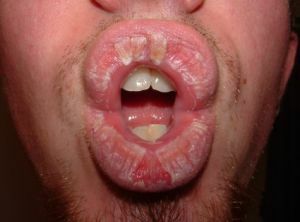 clear boundaries, located mainly in the corners of the mouth. The skin acquires a red tint, flakes, bleeds, becomes swollen.
clear boundaries, located mainly in the corners of the mouth. The skin acquires a red tint, flakes, bleeds, becomes swollen.
When the candidiasis cheilitis is exacerbated, the cracks are covered with the fringe of the exfoliating stratum corneum. Swelling is aggravated, a cyanotic shade is possible.
On the lips are visible scales, the skin seems to be tightened. Gradually it becomes thinner, there is burning, pain.
Diagnosis of
When diagnosed, the physician is guided by the patient's own testimony, visual examination of the oral cavity, and data obtained during laboratory tests. To confirm the suspicion of thrush is helped by microscopy scraping from the affected area of the lips and planting the pathogen into the nutrient medium. Also, a physician can direct a patient to give biochemical blood tests.
Medical care
The main purpose of treatment is to influence the causative agent and motivate the patient to eliminate the factors that provoke the progress of the disease. There are two ways to get Candida fungus to decrease its activity: systemic and local treatment.
Local therapy
Means the use of antifungal and antiseptic drugs. They are prescribed in the form of gels, solutions, drops, tablets. The main condition is to create a long contact of the medication with the affected surface.
When applying antiseptics, the patient is usually offered rinsing and lubrication.
Systemic exposure
Applicable in the absence of effect with prolonged local treatment or chronic form of thrush. Antifungal 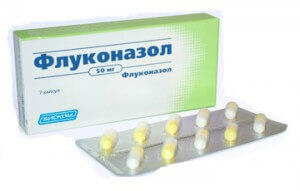 oral agents are prescribed in shock doses, during an exacerbation it is possible to supplement the therapy with Fluconazole.
oral agents are prescribed in shock doses, during an exacerbation it is possible to supplement the therapy with Fluconazole.
Immunity is supported by the selection of a complex of vitamins( C, PP, B), immunostimulants. The patient is shown proper nutrition with a reduced content of carbohydrates and the prevalence of proteins.
You also need to monitor personal hygiene, quit smoking, yeast-containing products, mouthwash.
The acute form of candidiasis of the lips gradually turns into a chronic one, in the absence of treatment the fungus spreads to other parts of the mucosa, larynx and stomach. Deep penetration of Candida into tissues causes difficulties in diagnosis and treatment. The damaged area is poorly treated, there may be festering foci, the transfer of microorganisms with blood to other areas.
Preventive measures
To prevent the fungus from settling on the lips, it is necessary:
- to observe the hygiene of the oral cavity;
- not to abuse the rinse aid, disturbing the balance of the microflora of the mucosa;
- regularly consult a dentist;
- to exclude from the diet yeast;
- to quit smoking;
- take vitamins and fortifying preparations.
Modern medicine quite successfully cures candidiasis on the lips, but one must understand that it is better to prevent the disease than after a long and not always successful attempt to get rid of it or the consequences of its course.
